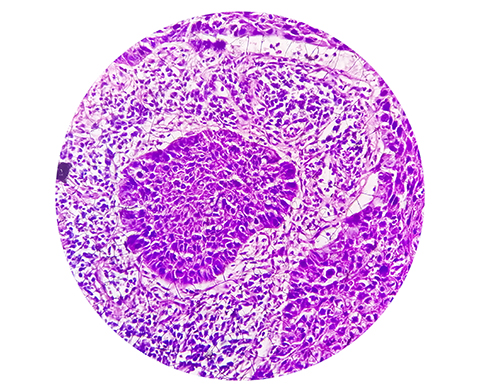Exploring glycosylation patterns in oral cancer
Oral squamous cell carcinoma, or OSCC, a cancer that affects the mouth, is an aggressive disease with a dishearteningly low survival rate. Doctors usually estimate an OSCC prognosis based on the size of the tumor at diagnosis and whether the cancer has spread to lymph nodes and other areas.
This system isn’t perfect, according to Carolina Moretto Carnielli, who studied the disease during her postdoctoral studies at the Brazilian Center for Research in Energy and Materials. “People with the same stage of OSCC can have different clinical manifestations and outcomes,” she said. “We need to better understand what molecular changes are occurring as the disease changes.”

To address this challenge, Carnielli turned to mass spectrometry–based glycomics and glycoproteomics to identify and characterize proteins and their glycosylation in tumor tissues from patients with distinct lymph node status, the main prognosis factor in oral cancer, offering insights into patient prognosis.
Glycosylation, a posttranslational modification involving the addition of glycan sugar molecules to proteins, plays a pivotal role in altering behaviors such as adhesion, migration and metastasis in oral cancer cells.
Carnielli’s mentor, Adriana Franco Paes Leme, guided her postdoctoral research, including an internship in the laboratories of Morten Thaysen–Andersen and Rebeca Kawahara, researchers from Macquarie University in Sydney, Australia, and the Institute for Glyco-core Research, Nagoya University, Japan, who supervised the study. Carnielli and colleagues comprehensively characterized the glycoproteome in primary tumor tissues from OSCC patients, both with and without lymph node metastasis, by using an integrative multiomics approach that combined glycomics and glycoproteomics.
“Part of the goal was to characterize the glycan structures, their site-specific heterogeneity and their dynamics at different stages of the disease,” Carnielli said.
While most of the tumor tissues had similar N-glycome profiles, suggesting a consistent pattern during cancer progression, Carnielli discovered that changes in the abundance of six specific sugar structures were associated with OSCC spreading to lymph nodes.
Recently published in Molecular & Cellular Proteomics, the team’s study also shows previously uncharted associations between protein glycosylation in OSCC tumor tissues and critical clinical outcomes.
For example, Carnielli showed that a comparatively high abundance of two core-fucosylated and sialylated N-glycans and one N-glycopeptide from fibronectin were associated with low patient survival. On the other hand, a relatively low abundance of N-glycopeptides from afamin and CD59 was also associated with poor survival.
“This work also highlights the significance of using a multiomics technique such as integrated glycomics and glycoproteomics to comprehensively study these modification patterns in diseases,” Carnielli said.
This research has far-reaching implications. When survival-associated N-glycans and glycopeptides in OSCC tumor tissues are identified, researchers understand that glycosylation makes a significant contribution to the disease progress, opening new possibilities to study associated mechanisms, tailoring personalized treatment strategies and predicting and monitoring disease outcome and progression.
“Some of these glycopeptides have the potential to serve as prognostic markers for OSCC outcome,” Carnielli said; thus, offering hope for improved approaches for informing clinical intervention and treatment of this often-lethal cancer.
Enjoy reading ASBMB Today?
Become a member to receive the print edition four times a year and the digital edition monthly.
Learn moreGet the latest from ASBMB Today
Enter your email address, and we’ll send you a weekly email with recent articles, interviews and more.
Latest in Science
Science highlights or most popular articles

Building the blueprint to block HIV
Wesley Sundquist will present his work on the HIV capsid and revolutionary drug, Lenacapavir, at the ASBMB Annual Meeting, March 7–10, in Maryland.

Gut microbes hijack cancer pathway in high-fat diets
Researchers at the Feinstein Institutes for Medical Research found that a high-fat diet increases ammonia-producing bacteria in the gut microbiome of mice, which in turn disrupts TGF-β signaling and promotes colorectal cancer.

Mapping fentanyl’s cellular footprint
Using a new imaging method, researchers at State University of New York at Buffalo traced fentanyl’s effects inside brain immune cells, revealing how the drug alters lipid droplets, pointing to new paths for addiction diagnostics.

Designing life’s building blocks with AI
Tanja Kortemme, a professor at the University of California, San Francisco, will discuss her research using computational biology to engineer proteins at the 2026 ASBMB Annual Meeting.

Cholesterol as a novel biomarker for Fragile X syndrome
Researchers in Quebec identified lower levels of a brain cholesterol metabolite, 24-hydroxycholesterol, in patients with fragile X syndrome, a finding that could provide a simple blood-based biomarker for understanding and managing the condition.

How lipid metabolism shapes sperm development
Researchers at Hokkaido University identify the enzyme behind a key lipid in sperm development. The findings reveal how seminolipids shape sperm formation and may inform future diagnostics and treatments for male infertility.

